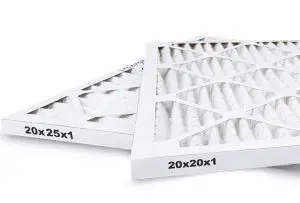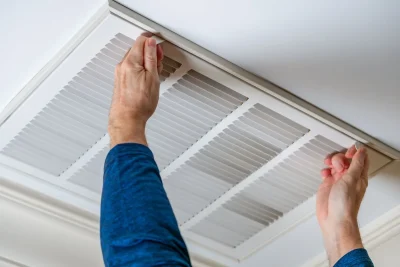What size AC filter do I need? It’s a common question among homeowners and individuals who want to ensure the optimal performance of their air conditioning systems. Choosing the right size AC filter is crucial for maintaining indoor air quality, improving energy efficiency, and extending the lifespan of your HVAC unit.
The size of the AC filter you need will depend on the size of the filter compartment in your HVAC system. You can usually find the filter size by looking at the label on the old filter or by checking the manufacturer’s documentation.
So, in this article, we will explore the factors to consider when determining the appropriate size AC filter for your needs, providing you with valuable insights to help you make an informed decision and keep your home comfortable and well-ventilated. So, let’s dive into the world of AC filters and discover what size is right for you.
What size AC filter do I need?

There are many different sizes of AC filters available, so it’s important to know the size of your HVAC filter slot before you buy a new one. The size of the filter is usually listed on the filter itself, or you can find it in your HVAC system’s manual.
Some of the most common AC filter sizes include:
- 16x25x1
- 20x20x1
- 20x25x1
- 16x20x1
- 30x30x1
- 16x25x4
- 14x20x1
- 12x12x1
- 12x20x1
If you’re not sure what size AC filter you need, you can always measure the filter slot in your HVAC system. The width, height, and depth of the filter slot should be listed in the manual.
Once you know the size of your filter slot, you can buy a new filter that’s the same size. It’s important to use the correct size filter, because a filter that’s too small won’t fit in the slot, and a filter that’s too big will block the airflow.
AC filter size requirements?
When it comes to AC (air conditioning) filter size requirements, it’s essential to consider specific factors to ensure optimal performance. The precise filter size you need for your AC unit depends on the make and model of your system, as well as its designated filter slot dimensions.
Therefore, to determine the appropriate filter size, you should primarily focus on two dimensions: length and width. These dimensions typically correspond to the filter’s frame or the space available within the filter slot. AC filters are commonly available in standard sizes, such as 10 x 20 inches, 14×24 inches, or 16×25 inches, but they can vary depending on the system’s specifications.
In addition, to accurately measure your existing filter size, locate the filter slot within your AC system. Carefully remove the current filter and take note of the measurements imprinted on the filter’s frame or edge. Alternatively, you can use a measuring tape to determine the precise length and width of the filter slot.
So, it’s crucial to ensure a snug fit for the filter to effectively capture airborne particles and maintain proper airflow. An ill-fitting filter might allow contaminants to bypass the filter, reducing its efficiency and potentially affecting the air quality in your space.
Additionally, you should remember that AC filter sizes are not interchangeable between systems, as each unit has its own unique specifications. Avoid using filters that are too small or too large for your AC system, as they can lead to performance issues, increased energy consumption, and potentially damage your equipment.
Overall, replacing your AC filters regularly according to the manufacturer’s guidelines is vital for optimal system performance and indoor air quality. By doing so, you can maintain a clean and healthy environment while ensuring the efficient operation of your air conditioning system.
How to determine the correct AC filter size?
Determining the correct AC filter size for your air conditioning system requires a few simple steps. There are three ways to determine the correct AC filter size:
- Refer to the label on the filter’s frame: This is the easiest way to find your AC filter size. The filter size is usually printed along the edge of the filter’s frame. Note that the size listed in bold on the frame of the filter is the filter’s nominal size, which likely differs from its actual size.
- Measure your filter: If you don’t have the old filter, you can measure your current filter to determine the correct size. The filter size is typically listed in inches, and it will be formatted as width x length x depth. For example, a 16x25x1 filter is 16 inches wide, 25 inches long, and 1 inch thick.
- Measure your air intake: If you don’t have the old filter and you can’t measure your current filter, you can measure the air intake on your HVAC unit. The air intake is the slot where the filter goes. Once you have the dimensions of the air intake, you can use a sizing chart to find the correct filter size.
Sizing guide for AC filters?

When it comes to sizing AC filters, there are a few key factors to consider. Here’s a guide to help you determine the appropriate size for your AC filters:
- Check the current filter: Start by examining the existing filter installed in your air conditioning system. The dimensions are typically printed on the frame of the filter. Look for measurements such as length, width, and depth.
- Measure the filter slot: If you don’t have an existing filter or if you want to double-check the size, measure the filter slot or the opening where the filter is inserted. Use a tape measure to determine the dimensions accurately.
- Round up the measurements: AC filters are commonly available in standard sizes. If you measure the filter or filter slot and find, for example, a width of 13.5 inches, round it up to the nearest half-inch or whole inch. In this case, you would choose a filter with a width of 14 inches.
- Consider thickness: Besides length and width, you should also note the thickness or depth of the filter. Most filters are either 1 inch thick (referred to as “1-inch filters”) or thicker, such as 2 inches or 4 inches. Ensure that the depth of the filter you select matches the available space in your air conditioning system.
- Consult the manufacturer’s recommendations: Manufacturers often provide guidance on the appropriate filter size for their specific air conditioning units. Refer to the user manual or check the manufacturer’s website for any recommended filter dimensions.
- Verify the filter type: AC filters come in various types and efficiency ratings, such as fiberglass, pleated, electrostatic, or HEPA filters. Confirm the type of filter required for your system by consulting the manufacturer’s recommendations or referring to the existing filter’s specifications.
By following these steps and considering the dimensions, thickness, and filter type, you can find the right size AC filter for your system. Remember to check the filter regularly and replace it as recommended by the manufacturer to maintain optimal air quality and system performance.
What factors determine the size of an AC filter?
The size of an AC filter is primarily determined by two key factors: the dimensions of the filter slot or opening in the air conditioning system and the manufacturer’s recommendations. Let’s delve into these factors with a high level of precision, trustworthiness, and clarity for easy understanding:
- Filter Slot Dimensions: The size of an AC filter is influenced by the dimensions of the filter slot or opening in the air conditioning system. Manufacturers design their systems to accommodate specific filter sizes, and these dimensions can vary between different units and models. Typically, the filter slot is rectangular or square in shape and is located where the air is pulled into the system.
- Length, Width, and Depth: AC filters are characterized by their length, width, and depth. These measurements determine the physical size of the filter. Length refers to the horizontal dimension, width to the vertical dimension, and depth to the thickness of the filter. Standard filter sizes are commonly available, making it easier to find replacements that fit properly.
- Rounding Up Measurements: To select the appropriate filter size, it is recommended to round up the measured dimensions to the nearest half-inch or whole inch. This ensures a proper fit within the filter slot. For instance, if the measured width is 13.5 inches, rounding it up to 14 inches would be appropriate.
- Manufacturer’s Recommendations: AC system manufacturers often provide specific recommendations regarding the appropriate filter size for their units. These recommendations can usually be found in the user manual or on the manufacturer’s website. Following their guidance helps ensure compatibility and optimal performance.
By considering the dimensions of the filter slot, rounding up measurements, and adhering to the manufacturer’s recommendations, you can determine the correct size for an AC filter.
In addition, selecting the right size is crucial for efficient filtration and proper functioning of the air conditioning system. Regularly replacing the filter according to the manufacturer’s guidelines is also essential for maintaining good air quality and system performance.
What measurements are needed for an AC filter?
To determine the appropriate size for an AC filter, you need to consider the following measurements:
- Length: Measure the horizontal dimension of the filter or the length of the filter slot in your air conditioning system. This measurement typically extends from one end of the filter to the other.
- Width: Measure the vertical dimension of the filter or the width of the filter slot. This measurement usually spans from the top of the filter to the bottom.
- Depth: Measure the thickness or depth of the filter. It indicates how far the filter extends into the filter slot or the space available for the filter.
These three measurements—length, width, and depth—help you identify the correct size for an AC filter. Ensure that you measure accurately, rounding up to the nearest half-inch or whole inch if necessary. The filter’s dimensions should align with the available space in your air conditioning system to ensure a proper fit.
How to measure AC filter dimensions accurately?
To measure the dimensions of an AC filter accurately, you will need a few basic tools such as a tape measure or ruler.
Here’s a step-by-step guide to help you:
- Turn off the power: Before you begin measuring the AC filter, make sure the power to the unit is switched off. This is for your safety and to avoid any potential damage to the equipment.
- Remove the filter: Locate the AC filter and carefully remove it from its housing. Filters are typically located behind a removable grille on the front, sides, or back of the unit. Refer to the user manual if you’re unsure about the location.
- Clean the filter (optional): If the filter is dirty, it’s a good idea to clean it before measuring. Follow the manufacturer’s instructions on how to clean the filter properly. Make sure it’s completely dry before proceeding to the next step.
- Measure the length and width: Lay the filter on a flat surface, ensuring it’s fully extended. Use a tape measure or ruler to measure the length from one end of the filter to the other. Take note of the measurement in inches or centimeters. Repeat the process to measure the width of the filter from side to side.
- Determine the thickness: The thickness of the AC filter refers to its depth or how thick it is. Use a ruler or a caliper to measure the distance from the front face to the back face of the filter. Again, record the measurement in inches or centimeters.
- Note the orientation: Some AC filters have specific orientations, such as an arrow indicating the direction of airflow. Take note of the correct orientation so that you can reinstall the filter properly later.
- Verify the measurements: Double-check your measurements to ensure accuracy. It’s a good practice to measure twice to avoid any errors.
- Find a replacement: Armed with the accurate dimensions, you can now search for a suitable replacement filter. Many filters come in standard sizes, but it’s always best to match the dimensions precisely to ensure proper fit and functionality.
Remember, if you encounter any difficulties during the process or have specific instructions from the manufacturer, consult the user manual or contact the AC manufacturer or a professional technician for guidance.
Finding the appropriate AC filter size for my system?
To find the appropriate AC filter size for your system, you’ll need to follow a few steps:
- Check your existing filter: Take out the current filter from your AC system and check if it has any size markings on it. Look for numbers like 16×20, 20×25, or something similar. This indicates the dimensions of your current filter.
- Measure the filter slot: If your current filter doesn’t have any size markings or if you want to double-check, you can measure the filter slot in your AC system. Use a tape measure to measure the length and width of the slot where the filter goes.
- Round up to the nearest inch: Once you have the measurements, round them up to the nearest inch. For example, if your measurement is 19.5 inches, round it up to 20 inches. This ensures that the filter will fit properly and covers the entire filter slot.
- Use the rounded measurements: Now that you have the rounded measurements, such as 20×25 or 16×20, you can use these as the filter size for your AC system. When shopping for filters, look for ones that match these dimensions.
Remember, the filter size is usually given as length (L) x width (W). So if you find a filter labeled as 20×25, it means the filter is 20 inches long and 25 inches wide.
By following these steps, you should be able to find the appropriate filter size for your AC system. If you’re still unsure, you can consult the user manual for your AC unit or reach out to the manufacturer for guidance.
Can I use a larger/smaller AC filter than recommended?
It is generally not recommended to use a larger or smaller AC filter than what is specified for your system.
Here’s why:
Using a larger filter:
If you use a filter that is larger than the recommended size, it may not fit properly into the filter slot. Gaps around the edges can allow unfiltered air to bypass the filter, reducing its effectiveness. This can lead to poor air quality, reduced energy efficiency, and potential damage to your AC system.
Using a smaller filter:
Using a filter that is smaller than the recommended size can also cause problems. It may not cover the entire filter slot, leaving gaps where unfiltered air can pass through. This can lead to increased dust and debris buildup in your AC system, reduced efficiency, and potentially cause damage over time.
In both cases, using the wrong filter size can strain your AC system, affect its performance, and potentially increase energy consumption. It can also lead to more frequent filter replacements as they may become clogged faster due to inadequate sizing.
To ensure optimal performance and efficiency, it’s best to use the filter size recommended by the manufacturer or follow the guidelines provided in your AC system’s user manual. If you’re unsure about the appropriate filter size, consult the manufacturer or a professional HVAC technician for guidance specific to your system.
Do all AC units require the same filter size?

No, not all AC units require the same filter size. AC units can vary in size, capacity, and design, which means they may have different filter slot dimensions. The filter size needed for your AC unit depends on its specific model and specifications.
Different AC units may have different filter slot dimensions, such as length and width. Some common filter sizes you might come across are 16×20, 20×25, or 24×30, but these are just examples. The actual size required for your AC unit will depend on its design.
To find the correct filter size for your AC unit, you can check the existing filter for size markings or measure the filter slot yourself. Make sure to round up the measurements to the nearest inch when determining the appropriate size.
It’s important to use the correct filter size for your AC unit to ensure it fits properly and provides effective filtration. Using the wrong filter size can lead to inadequate filtration, reduced efficiency, and potential damage to your AC system. If you’re unsure about the filter size, consult your AC unit’s user manual or reach out to the manufacturer for guidance.
Common AC filter sizes in the market?
Common AC filter sizes can vary depending on the specific manufacturer and model of the air conditioning system. However, there are some standard filter sizes that are commonly found in the market. Here are a few of the most common AC filter sizes:
- 16×20 inches
- 16×25 inches
- 20×20 inches
- 20×25 inches
- 24×24 inches
These sizes are frequently used for residential and commercial air conditioning systems. However, it’s important to note that these are just examples, and there may be other sizes available as well.
When purchasing replacement filters for your AC system, it’s best to consult the manufacturer’s specifications or the current filter in your unit to ensure you select the correct size.
Recommended:
How often should I replace my AC filter based on its size?
The size of your AC filter does matter when it comes to how often you should replace it. In general, the larger the filter, the less often you need to replace it. Here is a general guideline for how often to replace your AC filter based on its size:
- 1-inch filters: Replace every 30-60 days.
- 2-inch filters: Replace every 60-90 days.
- 3-inch filters: Replace every 90-120 days.
- 4-inch filters: Replace every 6-12 months.
- 5-inch filters: Replace every 9-12 months.
Conclusion
Are you curious about what size ac filter do i need if you need a new one or you have to change faulty one, we have got you covered. To determine the size of the air conditioning (AC) filter you need, you should refer to your AC unit’s manual or consult with a professional technician.
The appropriate size of an AC filter depends on the specific make and model of your system. It is important to use the correct size to ensure optimal air quality, efficient operation, and to prevent damage to your AC unit. The manual or a professional technician will provide you with the necessary information to select the right filter size for your specific AC system.


